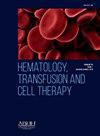MDS诊断?还要做骨髓检查吗?
IF 1.6
Q3 HEMATOLOGY
引用次数: 0
摘要
骨髓增生异常综合征(MDS)是一种异质性的克隆性骨髓(BM)干细胞髓系肿瘤,其特征是骨髓发育不良、巨细胞性贫血或细胞减少,并有白血病转化的倾向。MDS的怀疑是由典型但不具体的临床表现和常规实验室结果引起的,但诊断MDS的金标准仍然是BM检查,存在单系或多系发育不良和blast百分比,并排除其他原因。细胞遗传学也是诊断过程的一部分。流式细胞术和遗传学是有帮助的,但并不总是强制性的MDS的诊断。我们将总结目前的步骤,在诊断方法的病人怀疑有MDS。我还将描述使用非侵入性诊断技术的新概念,特别是数字方法和外周血遗传学。希望有一天这些技术能够成熟,被引入临床实践,甚至可能在许多情况下取代侵入性BM活检。本文章由计算机程序翻译,如有差异,请以英文原文为准。
MDS DIAGNOSIS? STILL BY BONE MARROW EXAMINATION?
The Myelodysplastic Syndromes (MDS) are a heterogenous group of clonal Bone Marrow (BM) stem cell myeloid neoplasms, characterized by BM dysplasia, macrocytic anemia or cytopenia with a tendency for leukemic transformation. The suspicion of MDS is raised by a typical but not specific clinical picture and routine laboratory findings, but the gold standard for the diagnosis of MDS is still BM examination with the presence of uni- or multi-lineage dysplasia and blast percentage, together with exclusion of other reasons. Cytogenetics is also a part of the diagnostic process. Flow cytometry and genetics are helpful but are not always mandatory for the diagnosis of MDS. We will summarize the current steps in the diagnostic approach for a patient suspected of having MDS. I will also describe new concepts that use non-invasive diagnostic technologies, especially digital methods as well as peripheral blood genetics. The hope is that one day these will mature, be introduced into clinical practice, and perhaps in many cases even replace the invasive BM biopsy.
求助全文
通过发布文献求助,成功后即可免费获取论文全文。
去求助
来源期刊

Hematology, Transfusion and Cell Therapy
Multiple-
CiteScore
2.40
自引率
4.80%
发文量
1419
审稿时长
30 weeks
 求助内容:
求助内容: 应助结果提醒方式:
应助结果提醒方式:


